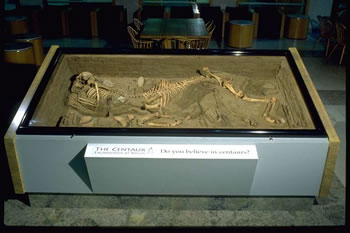Centaur of Volos September 5, 2010
Author: Beach Combing | in : Ancient, Contemporary , trackback All centaur-lovers with a honeymoon or a sabbatical coming up should buy a ticket to Knoxville, Tennessee and visit the second floor of the Hodges Library at the University there. Still encased in the Greek mud, in which it sank almost two thousand five hundred years ago, is a centaur, the only one you will find on display anywhere in the world. Poignantly a bronze arrowhead was extracted from its ribcage by careful trowels.
All centaur-lovers with a honeymoon or a sabbatical coming up should buy a ticket to Knoxville, Tennessee and visit the second floor of the Hodges Library at the University there. Still encased in the Greek mud, in which it sank almost two thousand five hundred years ago, is a centaur, the only one you will find on display anywhere in the world. Poignantly a bronze arrowhead was extracted from its ribcage by careful trowels.
Beachcombing would like to take those dry-as-dust doubters that populate our academies and rub their wretched noses in this proof of the noblest beast of antiquity, derided for too many centuries as legend. Look back at books on classical mythology from a generation ago and you will find ‘explanations’ for the centaur – Robert Graves to his eternal shame was one – claiming that centaurs were ‘attempts by frightened Greeks to make sense of their first glimpses of warriors on horseback’.
But that all ended in 1980. In that year of grace three centaur skeletons were uncovered by the Archaeological Society of Argos Orestiko, eight kilometres northeast of Volos, Greece. The find site is, of course, a closely guarded secret. But the hope that somewhere in the deepest Peloponese a small community of these animals still survives is most certainly not – after all, Beachcombing recently blogged on a late surviving Arabian group. And if anyone wants to contribute to the modern search for centaurs Beachcombing has the relevant Pay-Pal details.
OK, enough is enough.
The Centaur of Volos is a brilliant ‘hoax’ by William Willers, zoology professor and artist. Beachcombing has put hoax in inverted commas for the simple reason that Willers intention was not to deceive but to test the limits of belief. Indeed, the case at Knoxville asks students: ‘Do you believe in centaurs?’ that Beachcombing finds a runious imposition on the viewing experience, but anyway.
Incredibly the ‘find’ was, after a long itinerant voyage around various mid west museums, kept in storage before the Hodges Library took it out and put it in permanent display. In another ten years it will doubtless be the mascot for the college football team.
The dandy Adrienne Mayor, as so often says it best:
‘I think that the display allows us to spontaneously experience something like what many ancients must have experienced at the sight of the colossal, petrified bones of mammoths and samotheres, or the extraordinary bodies of Tritons and Centaurs, persuasively labeled as the actual remains of giant heroes and monsters of past worlds. The Centaur exhibit is just the kind of marvel that made Pausanias gasp and exasperated the natural philosophers.’ (241-242)
Indeed, it is.
Beachcombing suggests that Willers put in an entry to the Turner Prize. This prestigious modern arts award gave first place in 1997 to a video of policemen scratching themselves, to a room whose lights went on and off in 2001 and, in 2007, to a film of the winner dressed as a giant bear walking around an empty museum. All Willers has to do is knock up the anatomical framework of a dragon with some considerations from Derrida and the 25, 000 should be his for the taking.
Beachcombing would love to know of any other remarkable fakes of fantasy animals – not Liebnitz’s mistake though: drbeachcombing AT yahoo DOT com
***
Oct 1, 2010: On the subject of fabulous fake animals the great Adrienne Mayor was kind enough to put Beachcombing onto a baby dragon and Rick from the Anomalist remembered – how could Beachcombing have forgotten? – the Fiji Mermaid. Finally, J.Eb put Beachcombing onto a fabulous collection – with, for example, a Chimera a snip at 2000 dollars. Thanks Professor Mayor, J. Eb. and Rick!


